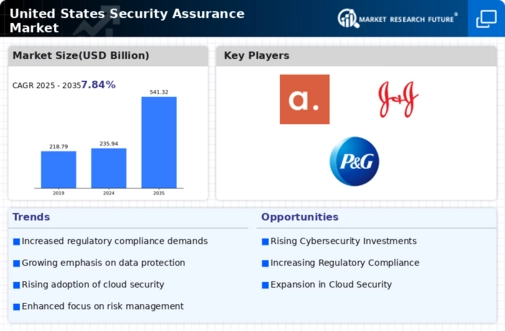Rising Cyber Threat Landscape
The security assurance market is experiencing heightened demand due to the escalating cyber threat landscape. Organizations across various sectors are increasingly targeted by sophisticated cyber attacks, which have surged by approximately 30% in recent years. This alarming trend compels businesses to invest in robust security assurance measures to protect sensitive data and maintain customer trust. As a result, The market is expected to grow significantly, with estimates suggesting a valuation exceeding $20 billion by 2026. The need for comprehensive security frameworks and continuous monitoring solutions is paramount, as companies strive to mitigate risks associated with data breaches and cyber incidents. Consequently, the rising cyber threat landscape serves as a critical driver for the security assurance market, pushing organizations to prioritize security investments and compliance with industry standards.
Increased Focus on Data Privacy
In the current digital age, the emphasis on data privacy has intensified, significantly impacting the security assurance market. With regulations such as the California Consumer Privacy Act (CCPA) and the General Data Protection Regulation (GDPR) influencing business practices, organizations are compelled to adopt stringent security measures. The market is witnessing a shift towards solutions that ensure data protection and compliance, with a projected growth rate of 15% annually. Companies are investing in security assurance frameworks that not only safeguard customer information but also enhance their reputation. This focus on data privacy is driving demand for security audits, risk assessments, and compliance certifications, thereby propelling the security assurance market forward. As businesses navigate the complexities of data privacy regulations, the need for effective security assurance solutions becomes increasingly critical.
Adoption of Cloud Security Solutions
The transition to cloud-based services is reshaping the security assurance market, as organizations seek to secure their cloud environments. With an estimated 70% of enterprises utilizing cloud services, the demand for cloud security assurance solutions is surging. This shift necessitates the implementation of security measures tailored to cloud infrastructures, including identity management, encryption, and threat detection. The market for cloud security solutions is projected to reach $12 billion by 2025, reflecting a compound annual growth rate of 20%. As businesses increasingly rely on cloud technologies, the need for comprehensive security assurance strategies becomes paramount. Organizations are prioritizing the integration of security measures into their cloud adoption plans, ensuring that data remains protected in a shared environment. Thus, the adoption of cloud security solutions is a significant driver of growth in the security assurance market.
Emergence of IoT Security Challenges
The proliferation of Internet of Things (IoT) devices presents unique security challenges, driving the demand for enhanced security assurance measures. With an estimated 30 billion IoT devices expected to be in use by 2025, the security assurance market is adapting to address vulnerabilities associated with these interconnected devices. Organizations are increasingly aware of the risks posed by unsecured IoT devices, which can serve as entry points for cyber attacks. This awareness is prompting investments in IoT security frameworks, including device authentication, data encryption, and network segmentation. The market for IoT security solutions is projected to grow at a rate of 25% annually, reflecting the urgent need for comprehensive security assurance strategies. As businesses strive to secure their IoT ecosystems, the emergence of IoT security challenges is a pivotal driver for the security assurance market.
Growing Demand for Managed Security Services
The increasing complexity of cyber threats is leading organizations to seek managed security services, significantly impacting the security assurance market. As businesses face resource constraints and a shortage of skilled cybersecurity professionals, many are turning to third-party providers for comprehensive security solutions. The managed security services market is projected to reach $30 billion by 2026, growing at a compound annual growth rate of 18%. This trend indicates a shift towards outsourcing security functions, allowing organizations to focus on core business activities while ensuring robust security assurance. Managed service providers offer expertise in threat detection, incident response, and compliance management, addressing the evolving security landscape. Consequently, the growing demand for managed security services is a crucial driver for the security assurance market, as organizations prioritize effective and efficient security solutions.














Leave a Comment